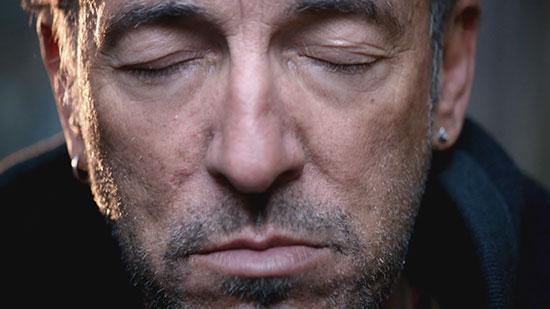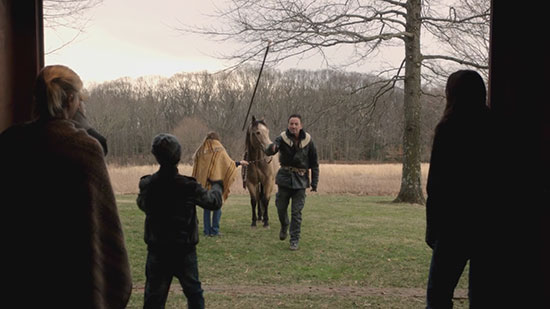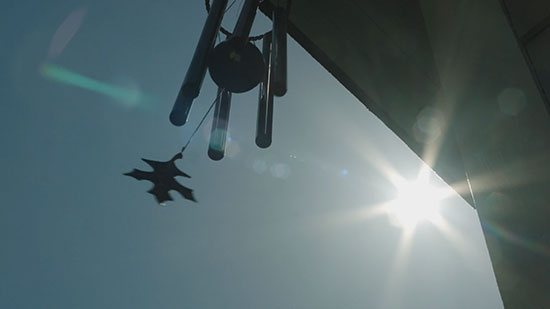
To celebrate Bruce's 65th birthday, the Friends of The Bruce Springsteen Special Collection and Monmouth University will be hosting an exciting evening of films presented by his archivist and collaborator Thom Zimny. On Tuesday, September 23, Zimny will be bringing a reel of footage from the vault to show on the big screen, as well as participating in a Q&A with Backstreets editor Christopher Phillips on the stage of Monmouth U's Pollak Theater.
Click here for more information on An Evening with Thom Zimny.
Click here to order $20 tickets for An Evening with Thom Zimny ONLY or, better yet, order by phone at 732-263-6889 to score the combo-ticket deal. For just $35, you'll get to attend both the 9/23 Thom Zimny event and Fifty Years of "Makin' This Guitar Talk" (lunch included) on 9/20.
For an advance taste, we've revisited a conversation Zimny had this summer on E Street Radio, focusing on the "Hunter of Invisible Game" film he made with Springsteen. Over the course of the July 16 show with host Dave Marsh, Thom gave a good deal of background on the short film; if you missed the broadcast, we've taken the liberty of editing his comments into a piece that gives more insight into the making of what Bruce called "one of our best."
Here's Thom:
 Jon Landau sent me the High Hopes album, and "Hunter of Invisible Game" was the one track that really stood out to me. (I even happen to have a son named Hunter, who got to work a bit with us on this film, which was nice.) When I had the chance, I talked to Jon about it, and that started a bit of dialogue with Jon and Bruce about the possibility of making a "Hunter" film. I think we just kept coming back to it. We would have a full journey with the live concerts. We were editing those and trying different things and different looks — experimenting — and at the same time doing some music videos for the High Hopes album. But we kept coming back to "Hunter," and I remember there was a moment where Bruce and I connected in New York and he just said, "It's gotta be grand, and we gotta go all out on this and tell a different story."
Jon Landau sent me the High Hopes album, and "Hunter of Invisible Game" was the one track that really stood out to me. (I even happen to have a son named Hunter, who got to work a bit with us on this film, which was nice.) When I had the chance, I talked to Jon about it, and that started a bit of dialogue with Jon and Bruce about the possibility of making a "Hunter" film. I think we just kept coming back to it. We would have a full journey with the live concerts. We were editing those and trying different things and different looks — experimenting — and at the same time doing some music videos for the High Hopes album. But we kept coming back to "Hunter," and I remember there was a moment where Bruce and I connected in New York and he just said, "It's gotta be grand, and we gotta go all out on this and tell a different story."
Early on, one of the forms of talking with Bruce about constructing the Hunter film was just through images, and a lot of his photography... getting these texts with just image ideas for the Hunter project. Certain landscapes will sometimes really say a lot to you emotionally and are great references. I worked with a fantastic cinematographer, Joe DeSalvo, and at times we would reference Bruce's stills for tone... and also sometimes just visual cues in terms of how the colors will play and what he's seeing in the landscape. That was a big part of it.
There was no formal script. There was a bit of dialogue back and forth, with texting and images, but in the cutting room... there's a freedom in the editing room that you find that will not translate on a scripted page. I tried to keep close to the tone of this song, and you couldn't really script images on paper that way. At least I wouldn't feel comfortable approaching it that way, so there was no formal script, and this film was found in the editing room.
Bruce's touring schedule, from my experience, doesn't hold back the intensity, focus, or dedication to a project, so he can be on tour and easily be sending ideas. There was a period of two days' shooting that we had, and then some other days that were just spread out around the touring schedule. And those were great days because we were able to really focus on this Hunter character and getting those narrative tones in there, but also concentrate on how we wanted to deliver the music and the environment in the world that he was set up in. Many of those choices were discussed, and you hope for a certain magic and light.
A lot of this is being open to "mistakes" that are happening in front of you and going, "Whoa! The building that's abandoned has an open roof, the sun is pouring through... Let's get this shot! Let's make sure that we get this line covered; that feels good." I worked with a crew that worked in a good space with Bruce, because those ideas are happening really fast and furious and in one day. You have a set plan, but it's like a setlist.

Bruce definitely had some opinions on how the scale of this should be. He shared a lot with me, but it developed more as you find different pieces of this character... as you find the jacket, the shoes. All of a sudden, these details come together, and with Bruce that's how you write a character. That's how you get the look of this character. That character putting on the glasses is not a Bruce that I recognize and know from the music or working with him for 14 years, but that was the character reflecting and looking at his past. I'm wearing many hats here, so I'm in the room as a director and as an editor and as a fan, but in this project, Bruce is playing a character that the fan in me doesn't recognize in any other reference.
We filmed all over New Jersey. Sandy Hook, NJ was something he suggested to me as a possible location for filming, and I went down there and took some stills. That location to me had a perfect balance. It felt like the strings, it felt like the song; I could see him walking through that grass. You have to carry the song around with you at all times and look at space that way, and sort of imagine how he will be "playing out" in this environment. And you don't want it to be too much of an apocalyptic or Mad Max surrounding but at the same time give that feeling, and I thought Sandy Hook had a great tone.

I always say this at the end of every project, but this collaboration was my favorite; this was great. Bruce was in the cutting room all the time, and really involved in his Hunter character, and that character's details. We pored over every detail of what is on that table in the film's opening shot and the way it was set up. It was a great experience for me, because I was able to carry the history of working previously with Bruce on the documentaries and the other music videos. We developed, I hope, a shorthand and trust that brought us to this place of Hunter, because there was no pre-discussion that "this is something that we will collaborate on." This was very classic Bruce where you get on the ride and you just go. It's open enough that you're not putting it in a box in a certain way, saying, "Okay, we're gonna do this. It's gonna be this collaboration and it's gonna be this way..." You're responding to things and images; and I also think some of the other films, concert videos, and music videos gave us the opportunity to sketch out certain ideas, certain compositions and use of color. All of that brought us to this place of collaboration on Hunter.
I'm really happy to say that I have 14 years with Jon and Bruce this summer, and there's no way that you can go that long not having a John Ford conversation with one of those guys. Those kinds of film references are really important to me and part of the film language that I'm attracted to, and I hear and see a lot of those things in Bruce's music when I'm listening to it as a fan.
Bruce came by the cutting room and we started cutting some images together and we built this opening to the film. And then he started to score against picture. When I say "against picture" I'm literally on the AVID editing machine cutting and he's composing the film's opening score to our cuts. That, to me, was the best experience... to give that space and let him create that way, and simultaneously look at how, working together, we were affecting the music. In the editing room, it's a bit of a cave; you get lost in the images and a story starts to unfold. With Hunter, having Bruce in the room with me and working with the images, it gave it this whole other level of interpretation, of playing with the images. We just took a lot of chances, and that was very freeing as an editor and gave me a lot.

I remember the chimes being something that I didn't have as a visual and he created musically. I loved them, and went and filmed a reference shot of that, because it started to make sense in what we were structuring as a grounding piece for that opening score. He was building that in front of me, and that influenced the whole cut and gave me opportunities to get certain images that I wanted.
Bruce has the ability to watch an image and instantly go back to the keyboard and structure out a sound that was not in sync to the image per se, in that he was not going for an image of chimes and then playing them. It was more like whatever he got in the emotion of those two seconds, and then went back and added a drone or strings and things like that, so it became layered and a piece while simultaneously building within picture. We're going from picture-editing to scoring back to picture-editing, etc. We're editing it, structuring it and roughing out this song, and all of a sudden it's like, "Wouldn't it be great if we had this, this and this? Yeah, let's try that." We go out and try to get those images. Now we go back to the editing room and we have those, and the score has gone to another layer, and then he has another amazing idea. You could go forever. Somehow, we got out of the editing room and we finished it... somehow. And we can't forget about Ron Aniello and the great work that he had with some of this.

Sometimes you get back to the editing room and you look at footage, and it just tells a certain story that you're hoping to get, and at the moment it might not be as powerful, but just for that second in the way light plays and the way the camera was composed, you nail a tone. And the best part of working with Bruce is that he can see dailies that way, and we went through every frame of all the dailies and built this thing that way. We would make sure that we followed that feeling and built the cut that way. He's looking at those dailies with the same amount of detail that I'm looking at them with as a director, but the editor in me is sometimes surprised at what he's putting together and seeing two images.
There was a gesture with a woman's hand and a rose. It was a beautiful, small moment, and Bruce said, "Wait; go back. I wanna see that." It was a flash, a small moment in the details, and he picked that out, and it's one of the great memories of the cutting room because it set up a tone that helped us build that edit in that section. It was able to get out a little bit of the loss and some of the feeling we were hoping to get across.
For me as a filmmaker, again it's really a great privilege to find something in the cutting room and have that freedom and direct dialogue with Bruce. I've had experience in episodic TV on The Wire, I've cut feature films and we've strayed from the script, and I've worked on all kinds of documentaries where you get raw footage and you find the story. But with Hunter, I've never before had the experience of someone being in the editing room this way, bringing music and bringing all these different layers to the editing experience, and also inspiring me to take chances in choices.
It's great to hear the impressions that people get from the images and the story unfolding. That track is so powerful that the last thing I would want to do is to say to somebody, "This is the story that you're seeing or hearing." And keeping that balance in the editing of the film was really my favorite part of the collaboration with Bruce. In certain choices, sometimes you'd just tip it to a scale that would explain it in a certain way or give it a certain tone that just was too much... too "on the nose" musically or lyrically, and so you pull back.
The last thing I want to do is define any Bruce Springsteen song. Doing the documentaries, I'm really aware that people have a history with Bruce's music and it's a very personal, passionate history. With a film like Hunter, you want to give new information and at the same time give an opportunity to step into the song differently, but not define it with your terms.

This film is really special to me. I'm just happy and grateful that it came at this point in my journey of working with Jon and Bruce and Barbara Carr. We've learned so much together, and having the trust of Bruce, Jon, and Barbara is a great thing. A project like this can be very intense, but I always start all over again with "What's the new track? What are we looking at, and what am I hearing?" And a big part of me starts all over again by being the fan, listening to the music and loving the music, sitting on the Point Pleasant boardwalk and hearing it in that space. As a younger filmmaker, one of the first things I tried early on with one of Dave Marsh's books was getting in the zone of trying to make videos with Bruce's music way before I had any opportunity to work with him. It's been a part of my life where I have sketched when no one wanted to see these little homemade videos, where the songs meant that much to me. (Still got 'em, too.) I try to hold onto that, and that keeps me in a grounded space so that I can approach each project with fresh eyes.
It was a gift at the end, and I was really happy that it was part of this gesture with Bruce at the end of the tour, because we started this record with the "Dream Baby Dream" video and to have it end with Hunter was a great treat. I love that it was a gift to the fans at the end of this really exciting time and chapter with the band and the music, and being part of it at all is just a great honor.
- adapted and re-sequenced by Shawn Poole from Thom Zimny's July 16, 2014 conversation with Dave Marsh and listeners on E Street Radio's Live From E Street Nation - stills from the short film Hunter of Invisible Game
Click here for more information on An Evening with Thom Zimny.
Click here to order $20 tickets for An Evening with Thom Zimny ONLY or, better yet, order by phone at 732-263-6889 to score the combo-ticket deal. For just $35, you'll get to attend both the 9/23 Thom Zimny event and Fifty Years of "Makin' This Guitar Talk" (lunch included) on 9/20.






